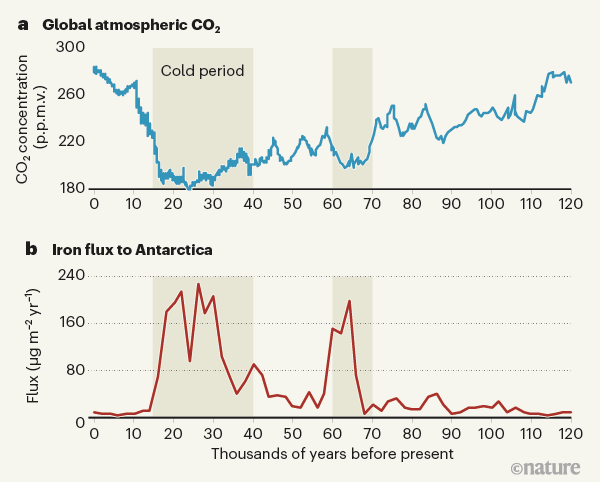Iron and Ice Ages
My "water in the mantle" super correspondent has also sent me THIS LINK. It looks at the connection between low CO₂ in the atmosphere and iron bearing dust in the oceans.
The idea is that the Southern Ocean has lots of the nutrients for biomass but biomass is low. The constraining factor is iron. In ice ages the lack of cover allows dust - including iron - to be blown out to sea where it allows the formation of biomass. Some of this sinks and therefore removes CO₂ from the atmosphere.
A fine theory, but how to prove it? More biomass getting to the ocean depths would provide food for deep-sea microorganisms. These would consume oxygen to process the extra food and therefore, in ice ages bottom waters would be oxygen poor. This has been found to be true with modern geochemical measurements.
Figure 1 | The anti-correlated data that inspired the iron hypothesis. a, Measurements of air bubbles trapped in cores drilled from the Antarctic ice sheet show that atmospheric levels of carbon dioxide were significantly lower during the coldest periods (shaded regions) than during modern times (data from ref. 16; CO2 concentrations are shown in parts per million by volume; p.p.m.v.). b, The ice-core records also reveal that more iron was transported to the Southern Ocean in wind-blown dust during the coldest periods than during warmer times (data from ref. 17; iron flux is measured in micrograms per square metre per year). In 1990, Martin2 hypothesized that the increased levels of iron in the Southern Ocean during the coldest periods fertilized the growth of photosynthetic microorganisms in the surface Southern Ocean, which therefore produced more biomass from CO2. This, in turn, would have increased the strength of the biological pump, a mechanism that sequesters some of the biomass (and the carbon within it) in the deep ocean. Martin proposed that the stronger biological pump explains why so much atmospheric CO2 is drawn into the ocean during cold times.

No comments:
Post a Comment